Samsung Galaxy Nexus & Ice Cream Sandwich Review
by Brian Klug & Anand Lal Shimpi on January 18, 2012 1:34 PM ESTCellular
From a cellular perspective there really are two entirely different Galaxy Nexii, as noted before. The GSM/UMTS (maguro) version which is slightly thinner, and the CDMA/LTE (toro) version which is on sale on Verizon at present and no doubt also Sprint later on when their LTE network is fired up. To accommodate those different combinations of air interfaces, Samsung made two very different phones.
GSM/UMTS Galaxy Nexus
| Galaxy Nexus (GSM/UMTS) - Network Support | |||||
| GSM/EDGE Support | 850 / 900 / 1800 / 1900 MHz | ||||
| WCDMA Support | 850 / 900 / 1700 / 1900 / 2100 MHz | ||||
| HSPA Speeds | HSDPA 21.1 (Cat.14) / HSUPA 5.76 (Cat.6) | ||||
| Baseband Hardware | Intel/Infineon X-Gold 626 w/I5712 transciever and RFMD RF6260 PA | ||||
Cellular connectivity on the GSM/UMTS Galaxy Nexus is courtesy of an Infineon/Intel X-Gold 626 (XMM6260). This is the same baseband as what shipped in the GT-I9100 SGS2, which isn’t much of a surprise at all. That means HSPA+ with HSDPA 21.1 (64QAM) and HSUPA 5.76. From a cellular perspective, the Galaxy Nexus is actually virtually identical to the GT-I9100 SGS2, and includes the exact same Infineon Smarti UE2 RF transceiver marked 5712, and the RFMD RF6260 quad-band multi mode (GSM/EDGE and WCDMA) power amp which works between 1710 and 1980 MHz, and 824–915 MHz, supplanting the need for individual power amps for each band. Of course, the 2100 MHz band has its own power amp elsewhere. The GSM/UMTS Galaxy Nexus also takes a regular size Mini SIM (not microSIM). In addition, though XMM6260 supports it, the Galaxy Nexus doesn’t include Rx diversity, and instead just locates its single cellular antenna at the very bottom of the device in one module, and the WLAN antenna off to the side.
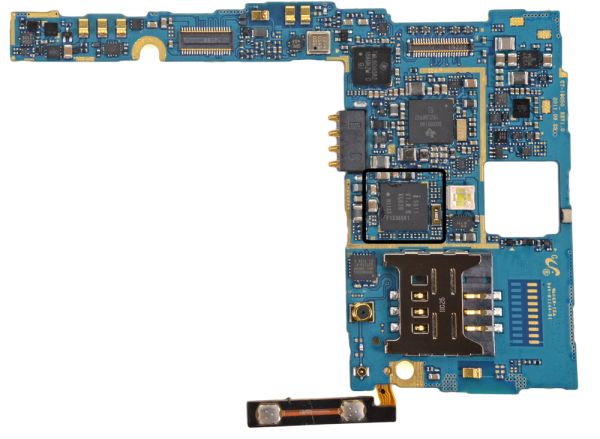
Intel X-Gold 626 circled in black above - Image courtesy iFixit
When the Nexus One (and later Nexus S) originally came out, I was puzzled by why Google hadn’t asked its OEM to include pentaband WCDMA support. Back in the Nexus One days, Google was making its big push to try and reshape the way smartphone shoppers buy phones in the US (and make things more like how the rest of the world does it). At the same time however, the hardware launched effectively only with the WCDMA band support for T-Mobile in the US. Third time is a charm, and the GSM/UMTS Galaxy Nexus is now both the first Nexus phone with pentaband WCDMA support, and, moreover, the only Android phone with pentaband WCDMA. The result is a new level of freedom - fully carrier-unlocked and hardware-unlocked hardware that is finally completely carrier agnostic (at least in GSM/UMTS land).
We tested the GSM/UMTS Galaxy Nexus on T-Mobile’s HSPA+ network and burned through the 2 GB of data on Google’s SIM before burning through another couple of GBs on our own T-Mobile SIM. All in all we ran over 200 tests and generated the histograms that normally grace our smartphone reviews.
T-Mobile HSPA+
Downstream Stats (Mbps) Avg: 3.522; Max: 8.689; Min: 0.029, StDev: 2.022
Upstream Stats (Mbps) Avg: 1.192; Max: 3.259; Min: 0.025, StDev: 0.814
Latency Stats (ms) Avg: 196.93; Max: 500; Min: 105, StDev: 57.122
Number of Tests Run: 244
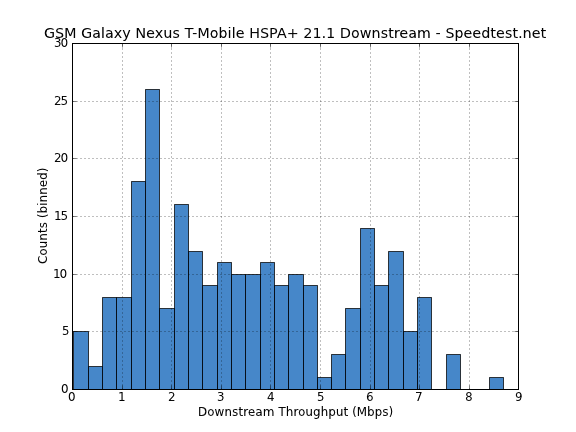
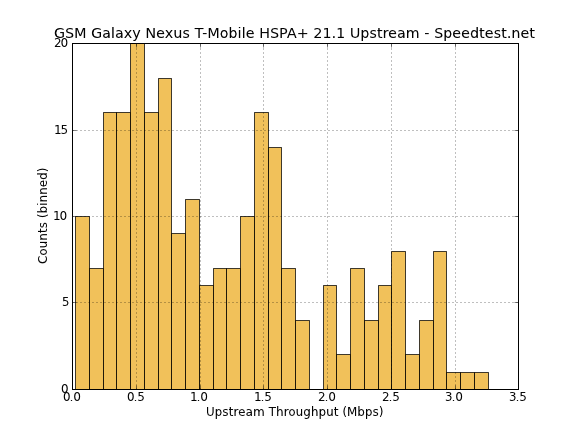
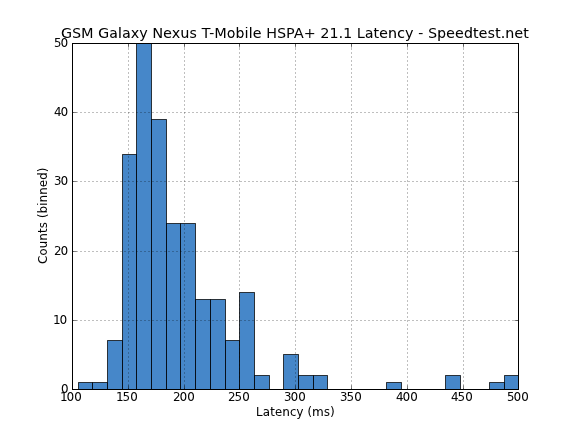
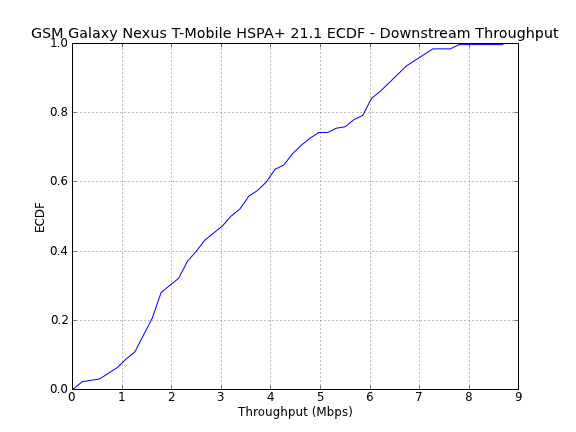

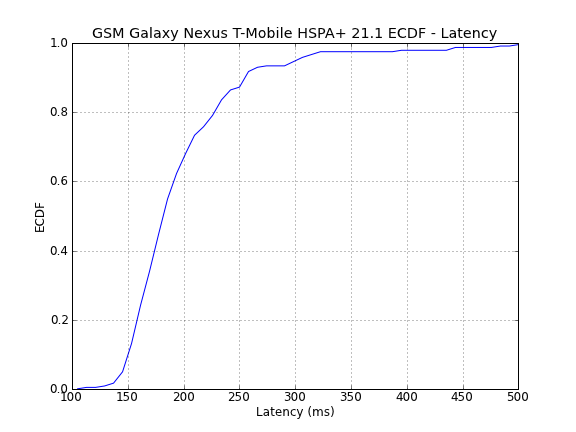
T-Mobile can be fast when it wants to, hitting 8 Mbps down at one point, and 3.2 Mbps up at another. Obviously the Galaxy Nexus is where it should be considering its HSPA+ category. I also tested the GSM/UMTS Galaxy Nexus on AT&T but didn’t run enough tests to generate the most meaningful histograms. I couldn’t get the Galaxy Nexus to go quite as fast as I’d expect it to on AT&T HSPA+ for some reason, even using the “phone” APN.
AT&T HSPA+
Downstream Stats (Mbps) Avg: 2.114; Max: 4.396; Min: 0.083, StDev: 0.979
Upstream Stats (Mbps) Avg: 1.201; Max: 1.681; Min: 0.043, StDev: 0.449
Latency Stats (ms) Avg: 280.479; Max: 951; Min: 107, StDev: 281.045
Number of Tests Run: 71
Oh, and needless to say, the Galaxy Nexus doesn’t suffer from any deathgrip or related signal propagation issues that I can identify.
CDMA/LTE Galaxy Nexus
When I caught wind of the fact that Verizon had also been selected as a launch carrier for the Galaxy Nexus, I speculated that Samsung would reuse the same cellular architecture it used in the Droid Charge. In that review, I talked about how the device used a combination of Samsung CMC220 for LTE, and VIA Telecom’s CBP 7.1 platform for CDMA2000 1x/EVDO. It’s a rather unique combination that also shipped in the Samsung Stratosphere.
| Galaxy Nexus (CDMA/LTE) - Network Support | |||||
| CDMA2000 1x/EVDO Support | EVDO Rev.A (800 / 1900 MHz) | ||||
| CDMA Baseband Hardware | VIA Telecom CBP7.1 with FCI FC7780 | ||||
| LTE-FDD Support | UE Category 3 - 700 MHz Band 13 | ||||
| LTE Baseband Hardware | Samsung CMC221 with FCI FC7851 | ||||
It makes sense for Samsung to reuse what work it has invested in making both Android’s Radio Interface Layer (RIL) and hardware work together for the Galaxy Nexus, and this turned out to be a pretty good educated guess. It turned out mostly correct - the CDMA/LTE Galaxy Nexus is based on a combination of Samsung CMC221 and VIA Telecom CBP 7.1.
_575px.jpg)
_575px.jpg)
Samsung CMC221 and VIA Telecom CBP7.1 - Courtesy ZDnet/TechRepublic
So what’s different between CMC220 and CMC221? No doubt, CMC221 simply is a revision of CMC220 which improves connection stability and handover performance, as one of my few complaints with CMC220 were the prevalence of paused connections in some environments.
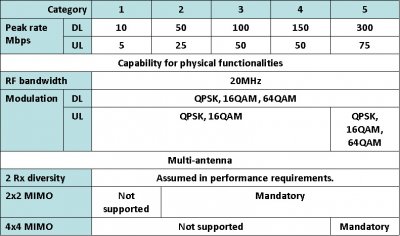
Beyond that, it’s hard to know exactly what’s changed, but suffice it to say CMC221 shares the properties with CMC220 that we care most about. It’s a UE Category 3 part - which is the current maximum for devices right now - it’s no doubt 3GPP Rel.8, and it supports 2x2 MIMO on the downlink. The CDMA/LTE Galaxy Nexus right now only operates on Verizon’s 10 MHz FDD LTE network, though Sprint is slated to get a CDMA/LTE Galaxy Nexus of their very own that will undoubtably be tailored to the 1900 MHz PCS block it deploys in. For now however, we’re just talking about the variant on Verizon 4G LTE.
I ran a bunch of tests on the CDMA/LTE Galaxy Nexus on Verizon 4G LTE and 3G EVDO networks. I tested 4G LTE in my Tucson, AZ market and honestly found using a UE Category 3 device quite refreshing after a long wave of UE Category 2 Motorola Wrigley. There is absolutely a difference in the kind of speeds you can see between devices, and I definitely consider the LTE Galaxy Nexus’s performance above average. I saw a maximum of 58 Mbps on the LTE Galaxy Nexus, though I didn't grab a screenshot. I did of one at 56 Mbps down, however.
Verizon Wireless 4G LTE
Downstream Stats (Mbps) Avg: 19.715; Max: 58.294; Min: 0.089, StDev: 11.744
Upstream Stats (Mbps) Avg: 7.437; Max: 19.711; Min: 0.242, StDev: 3.699
Latency Stats (ms) Avg: 87.312; Max: 188; Min: 63, StDev: 21.285
Number of Tests Run: 342
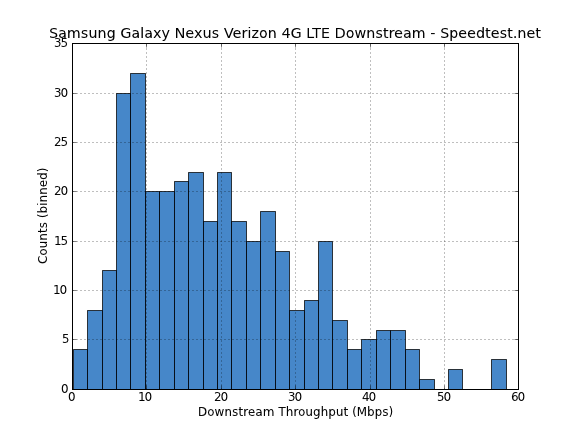
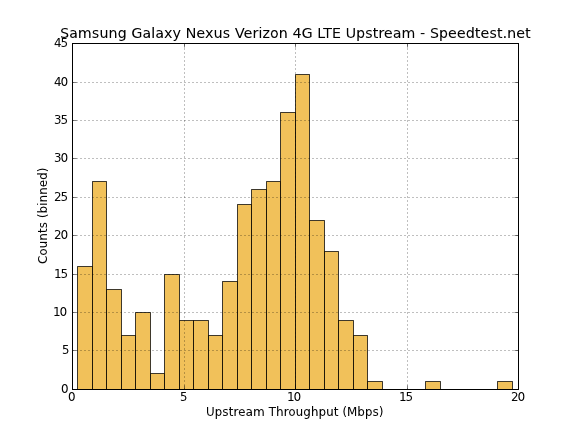
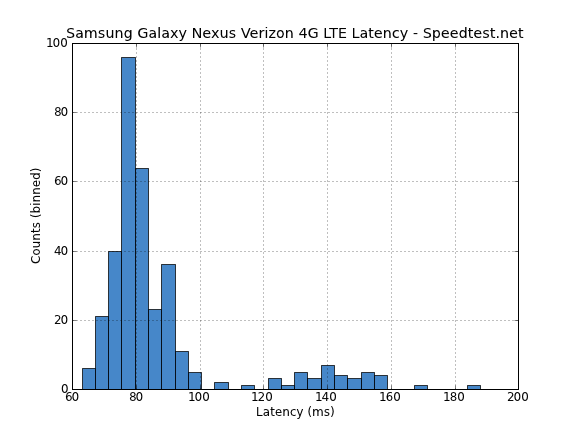

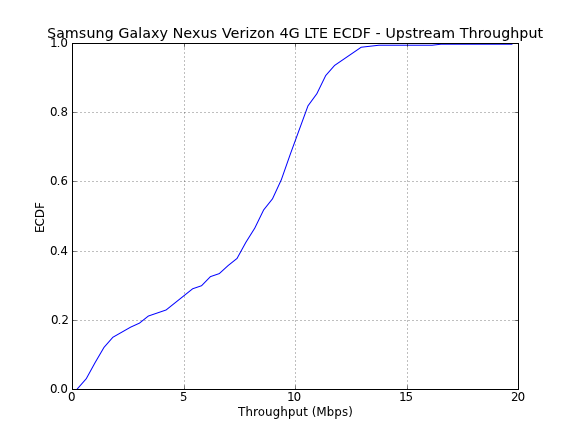

Again, I consider the 4G LTE performance of the Galaxy Nexus quite good, and I saw speeds in my market that I haven’t been able to achieve with other devices. The 58 Mbps test is pretty good, although I know a few other people I talk to have been able to hit over 71 Mbps on the Galaxy Nexus, and likewise consider its RF performance above average on LTE.
We also talked about the perceived LTE signal issue with the Galaxy Nexus at some length. Without revisiting the whole thing, the issue is with the way Android 4.0.2 paints signal bars as a function of signal strength. The Galaxy Nexus as of 4.0.2 does this in a way that isn’t in line with the other Verizon 4G LTE devices, and coupled with the fact that getting to LTE signal strength (and not 1x or EVDO RSSI) is difficult, misled many into thinking there was an issue when there really wasn’t one. I’ve continued comparing LTE RSRP (Reference Signal Received Power) between the Galaxy Nexus and other phones that report it, and have yet to see a significant difference. In addition, other LTE devices reported RSSI instead of RSRP - again it’s good that people are using numerics instead of bars (which are not standardized), however caution must be taken to compare the same parameters properly.
Of course, that’s really not all there is to talk about - what about 1x and EVDO performance on the VIA CBP7.1? My initial investigation only looked at 4G LTE, and since then I’ve had countless people email or otherwise notify me that EVDO also needs a good looking at.
I believe I’ve nailed down why there’s a perception that something is wrong with the Galaxy Nexus’ EVDO connectivity. Interestingly enough, the reason is again a nuance in the way that the device reports signal, but on EVDO. In particular, I noticed something in common with the Droid Charge that is no doubt unique to CBP 7.1. Namely, the baseband reports signal level in a quantized fashion at a few different levels in dBm. Ordinarily I see signal level quantized to just integer values, however on the CBP 7.1 based devices I’ve seen (like the Droid Charge and CDMA Galaxy Nexus) that quantization takes it to a few different levels. That means the values below are the only ones shown when connected to EVDO. You could be in an area with -51 dBm EVDO RSRP, but the maximum you’ll ever see reported is -75. There’s some hysteresis as well and the device doesn’t switch between levels that often.
-75
-83
-93
-100
-113
-120 (0 signal)
I have a sneaking suspicion that these values originally were designed to correspond to some decent cutoffs for signal bars (eg a 5 bar system with -120 being 0 bars), though I’m not entirely certain. The result of this quantization again is that you can be misled into thinking signal is worse or better than it really is depending on conditions, and I wager that this is what leads many to report that things are different than shown on other devices. I also compared EVDO signal strength between the CDMA/LTE Galaxy Nexus and a Droid Bionic, and quantization issues notwithstanding I saw very similar measures.
The caveat is that no doubt CBP 7.1 + FC7780 has different performance than the MDM6600 that has been ubiquitous for CDMA connectivity, so the fact that phones might perform differently in the same location doesn’t surprise me. That said, I’ve yet to see anything dramatic at all.
Nevertheless, I ran a ton of tests on EVDO (eHRPD is EVDO anchored through the PDN-Gateway) to test performance.
Verizon Wireless 3G EVDO Rev.A
Downstream Stats (Mbps) Avg: 0.891; Max: 2.525; Min: 0.07, StDev: 0.560
Upstream Stats (Mbps) Avg: 0.851; Max: 1.534; Min: 0.149, StDev: 0.254
Latency Stats (ms) Avg: 145.036; Max: 800; Min: 103, StDev: 97.1341
Number of Tests Run: 139
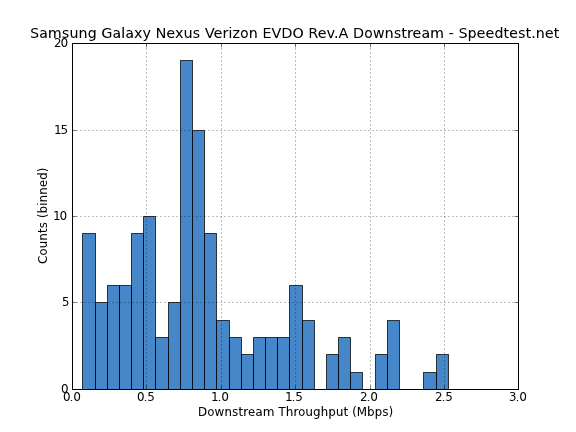
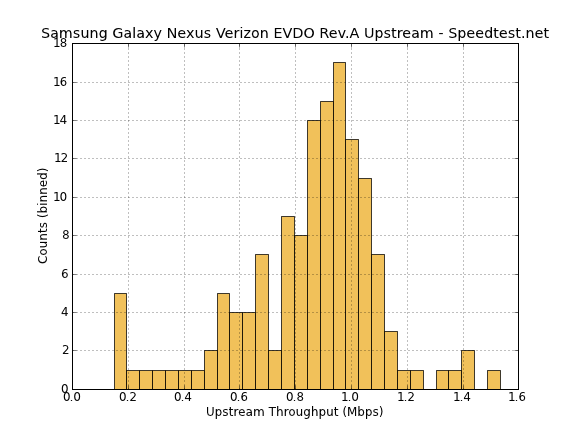
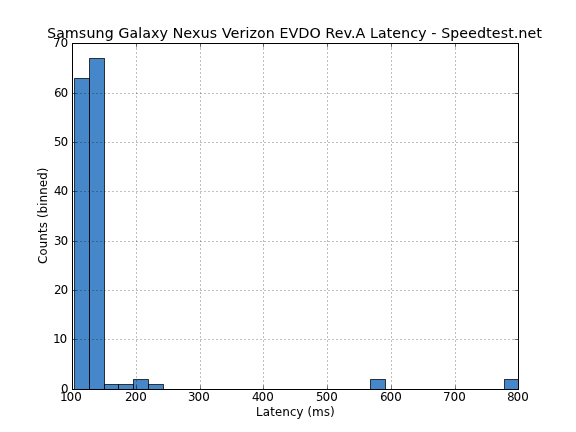



Honestly I can find nothing wrong with EVDO performance on the Galaxy Nexus. In fact, if you go back to the Droid 3 review, you’ll see that the Galaxy Nexus numbers are slightly higher in the upstream department and pretty similar (though differently grouped) on downstream.
Call Quality
I don’t usually include call quality measures in this section, but it also bears talking about since we’re dealing with some reports of things varying from what they’ve seen before on the CDMA/LTE Galaxy Nexus. Call quality on the GSM/UMTS Galaxy Nexus on T-Mobile is pretty par for T-Mobile 3G voice (AMR).
CDMA voice on the Galaxy Nexus does sound a bit different from other devices, however. Compare to the RAZR below which is again based on MDM6600 and its own vocoder.
It isn’t a huge difference, but enough to account for why many people have reported that voice sounds different on the CDMA/LTE Galaxy Nexus. Again, there are bound to be subtle differences between implementations, and I wager Qualcomm’s CDMA market domination in the US accounts for why the difference is something so many have talked about. It’s interesting to me that none of these nuances attracted as much attention with the Droid Charge, but then again I doubt as many people made a switch at that point.
That said, I’ve been using the CDMA/LTE Galaxy Nexus for almost all my calls, and did encounter one circumstance where voice continually cut in and out inexplicably. I haven’t experienced that behavior since.
When it comes to ambient noise suppression, both the CDMA/LTE Galaxy Nexus and GSM/UMTS Galaxy Nexus have a second microphone for common mode noise rejection. The microphone is right near where the battery cover makes contact with the top, slightly offset to the right. It’s a small port but easy enough to pick out.
I don’t know what solution is at play inside the Galaxy Nexus, but it honestly does a mediocre job suppressing noise, we’ve seen other phones definitely do better.


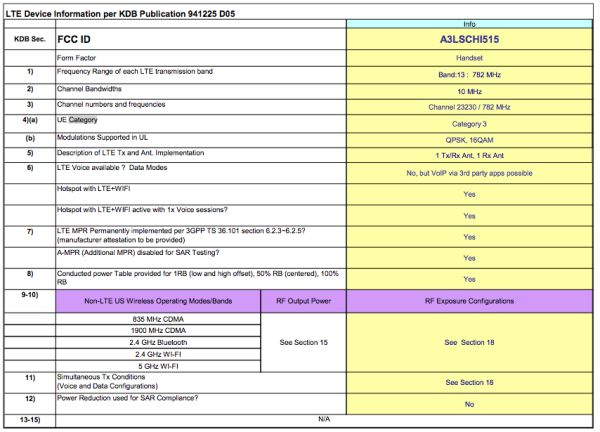









185 Comments
View All Comments
sjankis630 - Wednesday, January 25, 2012 - link
I can comment that my Galaxy Nexus' black is as black as midnight to a blind man.The only time I see some grey type tones is when the website is colored that way.
walkman - Sunday, January 22, 2012 - link
That was a shocking detailed and informative review -- It's the sort of article that makes Anandtech my first choice for tech reviews.- The article mentioned new processors just around the corner. Was this referring to any processors other than Krait? I haven't heard any news about Krait since November PR -- Are we looking at April or June? And do we think anyone besides HTC will use Krait?
Omid.M - Sunday, January 22, 2012 - link
Processors around the corner:Krait
Tegra3
OMAP5
Exynos 5250
It's going to be a bloodbath for the next 12-18 months.
If iPhone 5 uses the MDM9160 (?) modem with LTE, I'm jumping on that. Tired of tweaking battery life on my Thunderbolt. Not sure I want to do the same with a Galaxy Nexus LTE.
And what's this I'm reading about connection issues / dropped calls on the VZW Nexus? Ridiculous.
Rictorhell - Monday, January 23, 2012 - link
I am a big fan of this site and I read the reviews and articles all of the time and I find them very informative and useful, but, I have a request.When a review is written, particularly about a certain smartphone or tablet, it is mentioned whether the device has an SD card slot and you always tend to differentiate between whether it is a “full-sized” SD slot or a “micro”SD slot. That is useful to know, but there are several actual types of SD cards available, each with a different maximum storage capacity, and you don't specify in your reviews which types of SD cards are actually supported by the device being reviewed and I think that is a bit of an oversight.
To the best of my knowledge, standard SD cards only have a maximum capacity of up to 2gb, while SDHC cards can go up to as high as 32gb, and SDXC cards, while only available right now in sizes up to 128gb, are supposed to theoretically be able to be manufactured in sizes up to 2tb.
There is a huge difference in size between 2gb, 32gb, and 128gb. Given that smartphones and tablets have substantial built in limits as far as storage capacity, I think it would be very helpful to know which type of SD card is supported by which device, if that is possible.
If I read two reviews about two different Android tablets and both reviews mention that both cards have a full-size SD card slot, as a user with a lot of media files, I'm going to be interested to know if one of those tablets can support SDXC cards while the other one cannot.
I consider that to be a major feature, to me, just as important as battery life. If you do reviews of tablets and smartphones, or even ultrabooks, and neglect to specify how much storage potential these devices have or do not have, you are making it very easy for the hardware manufacturers to simply put in second rate storage and format support, knowing that it will not be covered in reviews by sites like Anandech. Not only is this going to stunt the evolution of these devices but it's also going to mean less options for consumers.
Anyway, thank you for your time.
peevee - Tuesday, January 24, 2012 - link
Anand, please include OS version number (and carrier when applies) in the charts for performance and battery life tests. They make huge difference, as browser speeds improve, they consume less CPU time and less energy when browsing.For example, the discrepancy between iPhone 4 and iPhone 4S looks outsized and probably is the result of testing iPhone 4 with iOS much older than the current version, probably not even 4.3, and 4S with iOS 5.
skinien - Tuesday, January 24, 2012 - link
What a review!!! I'm not in the market for a new hone right now, but when the time comes, I'll be looking here for a review on prospective phones. GREAT WRITE UP!sonicmerlin - Thursday, January 26, 2012 - link
I'm sorry, but you're ignoring the fact that ICS STILL lags. If you load up a heavy site like theverge, try scrolling around while the site is loading. Your entire page stutters and freezes until everything is done loading. ICS also lags more as you load more apps onto your phone, just like all previous versions of Android. Also notice how all UI elements are flattened when pages are rendered. Try zooming in or out. The new page info appears all at once, rather than pop up individually as in iOS and WP7. This can result in lag on heavy sites.For whatever reason tech "nerds" don't seem to notice the very obvious fluidity issues. Yes once you've loaded up a site it's easy to pan around, but people don't sit there patiently waiting for websites to load. Nor do they appreciate the frequent microstutters due to garbage collection issues, or the massive standby battery drain issues that tons of Android phones experience. And even the basic phone UI itself still lags behind your finger, demonstrating an irritating rubberband affect.
It's stupid. Android will never stop lagging until Google rewrites the OS to give the UI thread priority, instead of putting it at the same level as app priority.
rupert3k - Friday, January 27, 2012 - link
Learned loads from reading this, really impressed with how far Android has come.The stuttering when scrolling, zooming or browsing always annoyed me, stoked to learn ICS is fully accelerated.
One wonders if we'll see any Motorola Nexus style devices once Google settles into their new ownership. Be nice to see a Motorola this nice!
Hope we see high dot pitch Android devices to combat Retina, not happy with AMOLED at present it seems a bit yellowy & over saturated to me, surely LG or Samsung can also spec Retina style IPS or at least offer the choice between AMOLED & IPS 330dpi.
Bring on the Quad high DPI Android & iOS tablets!!
bruce3777a - Sunday, January 29, 2012 - link
Hi,Please bear with me:)
If a phone was upgraded from Gingerbread to ICS and It appears to be able to still work with the apps from many banks
It seems like these apps were not compatable with tablets running honeycomb so it was necessary to just use the browser.
If a tablet is upgraded from Honeycomb to ICS, or if a new tablet is purchased that has ICS would/should that automatically make it compatable, or is there still something that the banks would need to do to make it universal to both phones and tablets that use ICS. Thanks in advance for any insight.
Lucian Armasu - Monday, January 30, 2012 - link
I think I figured it out. I just saw this:http://score.nena.se/nenamark/view?version=2&d...
And I remembered it's not the only time I see 1196x720 pixels being rendered in a benchmark. Anand, if you're reading this, could it be because the buttons are NOT rendered by the GPU, and instead are rendered by those Cortex-M3 2D cores? They would have to render much fewer pixels, but they are also much slower than the GPU, and also pretty old tech I think.